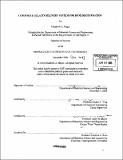Composite gelatin delivery system for bone regeneration
Author(s)
Hager, Elizabeth A. (Elizabeth Ann)
DownloadFull printable version (1.697Mb)
Other Contributors
Massachusetts Institute of Technology. Dept. of Materials Science and Engineering.
Advisor
Jackie Y. Ying.
Terms of use
Metadata
Show full item recordAbstract
In this thesis, the chemical/mechanical properties and biocompatibility of gelatin were investigated to produce a gelatin scaffold for the release of bone morphogenetic proteins (BMPs) from composite particles. This delivery system, designed to regenerate bone, holds much promise as an alternative to bone grafts. The chemical properties of gelatin were examined through zeta potential measurements, swelling studies, optical microscopy, environmental scanning electron microscopy (ESEM), and collagenase degradation. Compressive tests and mercury porosimetry were performed to study the mechanical and structural properties of the scaffold. The biocompatibility of the scaffold was determined through cell optical imaging and DNA quantification studies. Based on findings of this research, the material choices were made and the synthesis method for the gelatin scaffold was developed. Gelatin A, 300B, derived from bovine collagen, with an isoelectric point of [approx.] 9, was selected. Crosslinking was accomplished by reacting 10 w/v% glutaraldehyde with 10 w/v% gelatin solution. The most effective crosslinking condition was found to be 5 hours at room temperature. Glycine rinses were conducted to cap any non- reacted (toxic) aldehyde groups, and the necessary length of time was found to be at least 48 hours at 37⁰C. Finally, based on pore size distribution and mechanical stability, an optimal lyophilization method was developed with initial freezing at -20⁰C for 1 day, followed by lyophilization of the scaffold for 1-2 days. In terms of mechanical properties of the gelatin and amount of protein delivered, the most effective loading of poly(lactic-co-glycolic acid)/apatite/protein composite particles was found to be 10% of the mass of the gelatin.
Description
Thesis (S.B.)--Massachusetts Institute of Technology, Dept. of Materials Science and Engineering, June 2005. Includes bibliographical references (p. 38-39).
Date issued
2005Department
Massachusetts Institute of Technology. Department of Materials Science and EngineeringPublisher
Massachusetts Institute of Technology
Keywords
Materials Science and Engineering.